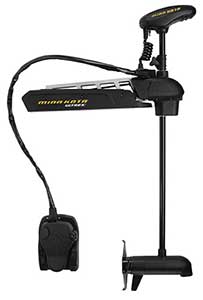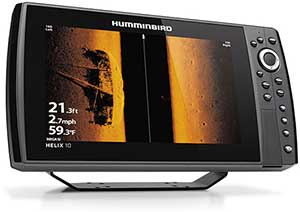By Louie Stout
If you want to become a more efficient boat angler but haven’t utilized modern technology, you might want to take a closer look at what’s available.
Sonar electronics and electric trolling motors are improving angler efficiency at a rapid pace.
Sure they’re expensive add-ons. But if you fish often, you’re going to appreciate what they can do for you.
Sonar units are no longer bottom finders or fish finders. When incorporated with mapping chips, GPS, high-powered imaging and a basic understanding of the kind of areas that hold your favorite sportfish, these electronics can literally put you on top of a hotspot.
And when you get there, GPS enabled electric motors can hold you on the spot without you manipulating controls.
I’ve spent the past few years testing some of the new equipment and can assure you that these improvements are very applicable for our waters.
 Minn Kota UltrexTrolling motors: The most recent change has occurred in foot-controlled electric motors, such as the kind anglers mount on the bow of their boats. They allow you to make minute steering and speed corrections while fishing through an area.
Minn Kota UltrexTrolling motors: The most recent change has occurred in foot-controlled electric motors, such as the kind anglers mount on the bow of their boats. They allow you to make minute steering and speed corrections while fishing through an area.
Presently, MotorGuide and Minn Kota offer the only bow mounted electric motors, but it’s been the Minn Kota Ultrex that has been labeled a “game changer” by far more experienced anglers than me.
The motor is truly remarkable. It is the only cable-steered, GPS enabled motor on the market that allows GPS to take control of the motor and hold you on one spot by simply engaging a “spot-lock” button on the foot pedal.
MotorGuide offers similar features in its X-i5 model, but it is electronic steered as compared to the Ultrex’s more traditional cable steer. Electronic steered motors aren’t as user friendly and slower to respond to angler adjustments.
The Ultrex is such a big deal that many pro bass anglers who were sponsored by MotorGuide made the switch at their own expense. In fact, all but 10 of the 107 Bassmaster Elite anglers are using the Ultrex whereas the field once was dominated by MotorGuide.
And we’re talking about an electric motor that costs in excess of $2,000.
Sound pricey? When compared to standard models, it is, yet production of the new motor can’t keep up with sales.
Imagine fishing offshore on a windy day and hooking a really big fish.
Without the Spot Lock feature, you must relinquish boat control to play the fish into the boat. By the time you’re finished, you’ve drifted several yards off the spot. And when you try to return, there’s no guarantee you will find the “exact” spot. With Spot Lock engaged, GPS manipulates the propeller to adjust for wind and hold you right there. You can make that same cast without leaving the spot.
It’s like having an anchor without the rope.
In addition, you can program the motor to take you to another waypoint, to follow a specific depth contour, or to turn around and make another pass along the same route you just fished. And you can do that without touching the motor.
Rumors in the marketplace contend more companies will enter the trolling motor market within the next year or so with their version of spot lock.
 Humminbird HelixElectronics: If your sonar electronics are more than three years old, you’re missing out amazing, yet rapidly changing technological advancements.
Humminbird HelixElectronics: If your sonar electronics are more than three years old, you’re missing out amazing, yet rapidly changing technological advancements.
Features on premium units two years ago already are finding their way into less expensive models, regardless of the brand.
Two of the most notable, known as “down imaging” and “side imaging” on the Humminbird and similar names on other brands, are definite players in Michiana. Humminbird’s “mega-imaging” on its premium units provides a remarkable picture compared to previous versions.
Nearly all electronic manufacturers now offer standard down and side imaging on mid-priced units, so it’s becoming more affordable. Those features allow you to see much more detailed pictures of the bottom either directly under the boat or off to the sides. The pictures are nearly as clear as a close-up photograph!
Here’s an example. Last summer, I was fishing a drop off I’m very familiar with on Diamond Lake near Cassopolis. I was watching my Humminbird Helix Side Imaging unit with Mega Imaging and discovered the outline of an old, partially covered row boat lying on the bottom in 22 feet of water – some 50 feet off the starboard side of my boat. I had been over that spot dozens of time, but I had never noticed it on previous units I have used.
I’ve also recorded trees and brush – likely planted by anglers – with the unit’s “Down Imaging” feature. I could discern branches and limbs clearly. I’ve even marked fish in those limbs and could distinguish their sizes. I’ve also seen schools of suspended bluegills in deep water with larger predators lying in ambush beneath them.
As valuable as high tech gadgets can be for saving time and finding potential hotspots, they don’t take the fun out of fishing nor do they make the fish bite.
You still have to figure that part out.


